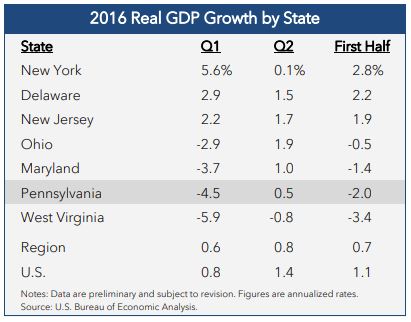December 2016
January 03, 2017 | Revenue & Economic Update

The U.S. Bureau of Economic Analysis recently released real gross domestic product (GDP) by state for the second quarter of 2016. The release includes revised quarterly statistics for 2005 to 2016. The table shows real GDP growth at annualized rates (first and second quarters and first half of 2016) for Pennsylvania and contiguous states. The growth of real GDP measures total economic output (adjusted for inflation), and can be used to evaluate the rate at which a state economy expands or contracts. In Pennsylvania, real GDP declined at an average annual rate of 2.0% in the first half of 2016. The decline was driven by a 4.5% drop in the first quarter. Real GDP growth picked up in the second quarter, increasing 5.0 percentage points to 0.5%. During the first half of the year, real GDP growth in surrounding states ranged from 2.8% in New York to –3.4% in West Virginia.
The U.S. Bureau of Economic Analysis divides GDP into different sectors for reporting purposes. For Pennsylvania, real GDP growth in the first half of the year was motivated by gains in agriculture (54.8%), utilities (18.0%), professional services (4.8%) and manufacturing (2.0%); and by losses in mining (-29.8%), management (-8.8%), government (-8.7%) and real estate (-4.5%). Excluding real estate, Pennsylvania’s largest private sectors: manufacturing, healthcare, information and professional services, which comprise nearly 40% of state GDP, were more resilient (1.4% growth, weighted average) than the overall state economy.
For the first half of 2016, real GDP grew more slowly in Pennsylvania and its contiguous states (0.7%, weighted average) than the U.S. as a whole (1.1%). The far west and rocky mountain regions grew faster than the U.S. at 2.8% and 1.4%, respectively. Some of these gains are attributable to population growth (see below). By contrast, the southwest and plains regions grew more slowly than the U.S. at 0.1% and –1.9%, respectively. These regions are particularly vulnerable to fluctuations in the energy sector, which contracted significantly in recent years.
It is important to note that real GDP growth does not control for population changes, which can have a positive (population increases) or negative (population declines) impact. According to the Pennsylvania State Data Center, six states recorded population declines from 2015 to 2016, including Pennsylvania (-0.1%) and West Virginia (-0.5%). The population contraction explains some of the weakness in their real GDP growth rates from the first half of 2016.